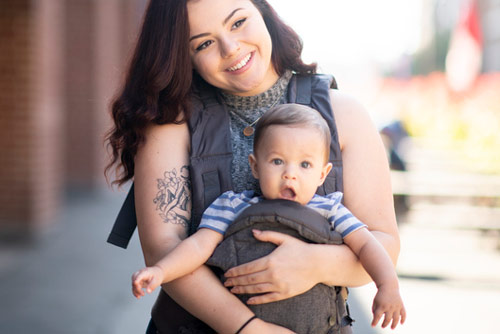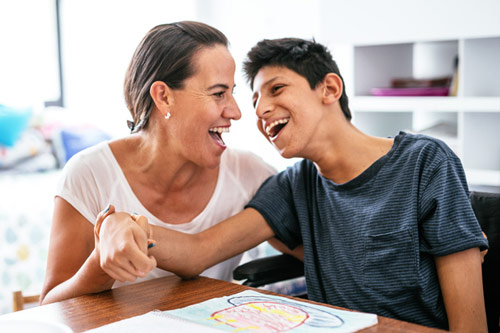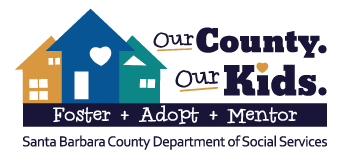
Adoption is a legal process that permanently gives parental rights to the adoptive parents. It includes welcoming a child as a permanent member of your family, providing and caring for their needs as they develop throughout their formative years, and showing them the love and support they need to develop to their full potential.
Santa Barbara Department of Social Services offers adoption services and is able to facilitate adoptions of children in foster care as well as assist birth parents who are considering relinquishing their child for adoption. If you are a birth parent who would like more information about the adoption process and available options, please call (805) 346-7127 and ask to speak to the Adoption Program Supervisor
Adopting a Child in Foster Care
The majority of foster children adopted through Santa Barbara County Department of Social Services enter foster care through no fault of their own; most often as a result of mental/physical abuse, exploitation, neglect, or abandonment. In addition to the trauma caused by the abuse and neglect, children in foster care may also encounter additional trauma as a result of being uprooted from their families, communities, and everything they know. Furthermore, many have experienced the difficult task of adjusting to new families, neighborhoods and schools while in foster care. They need people in their lives who will do whatever it takes to provide the nurturing and secure environment all children deserve to develop to their full potential. Though it is possible to adopt an infant from foster care, the children who are in need of stable prospective adoptive homes vary in age. Generally, children in foster care range from toddlers to 21 with the median age of 8 years old. Adopting a child from the child welfare system is a unique process that is most successful when prospective adoptive parents have the personal ability to support a child as the court assesses and makes the decisions to place the child for adoption. This ability doesn’t necessarily have anything to do with income, age, marital status, or any other type of concrete requirement. A child in the foster care system needs a resource family that is able to be patient, flexible, compassionate and loving. An important aspect of fostering, even while the foster family is being considered to adopt the child in their care, is that resource parents must actively support efforts to reunify children with their birth parents so long as reunification remains the child’s permanency plan.
Who Can Adopt?
Except for certain criminal convictions such as violent or sexual crimes against children, there are few circumstances that automatically disqualify an applicant from adoption. The following may help dispel some common myths about who can adopt:
- Applicants may be single, married, partnered, divorced, widowed or legally separated
- Home ownership is not necessary
- Both parents may be working and one parent does not need to stay home with the child as long as appropriate child care arrangements are made
- There are no set income requirements—adoptive applicants need to show they can meet their new family’s basic needs
- The adoptive applicant and the child do not have to be the same race, color, or of the same national origin
- Sexual orientation is not a barrier to adopting from foster care in California
- Age is generally not a barrier. As long as prospective parents are in good health and have the energy and desire to be a parent, age is not a deciding factor. A 50 to 55-year-old person or couple may be perfect for the adoption of an older child or siblings.
Adoption through Santa Barbara County DSS requires involvement with the dependency court and adherence to public child welfare regulations. As a child-focused agency, our primary responsibility is finding families for children to meet their individual needs.

Steps to Adoption
In order to adopt, interested individuals must first be approved as Resource Families in order to care for the child until the adoption is finalized. Relatives of children in foster care, who wish to adopt, also go through the same Resource Family Approval process. However, there are circumstances when a relative interested in placement can receive emergency placement of the child prior to completion of the Resource Family Approval.
The steps to adoption include:
- Complete Online Resource Family Approval Orientation
- Complete the required Pre-Service Training and Paperwork
- Livescan Fingerprinting, TB Test and Medical Clearance
- Complete a psycho-social study
- CPR & First Aid Training
- Complete a Resource Family Home Visit
- Welcome a child in foster care into your family
- Finalize and Celebrate Your Child’s Adoption
For more information about becoming a Resource Parent, click here.
After a child is placed in your care and the courts have ruled that adoption is in the best interest of the child you will be assigned a social worker who specializes in the adoption process. The adoption social worker will work with you to complete the adoption process and conduct an adoption child-parent suitability assessment with you.

Post-Adoption Contact Agreements
Post-Adoption contact agreements have become more and more prevalent in the State of California and across the country due to the growing awareness of the detrimental effects of secrecy in adoption and the benefits for an adopted child. A large number of adoptees have returned to adoption agencies seeking information and social media is connecting adoptees to their biological families. Choosing openness at the time of adoption may provide greater control, allow you to prepare for contact in the future, and helps with ongoing facilitated communication between parties. The child must have a preexisting relationship with the relative for the relative to enter into a post-adoption contact agreement. Post adoption contact agreements are governed by California Code 8616.5 and CDSS Title 22 Adoption Program Regulations Section 35064.
Agreements for post-adoption contact are only allowed and encouraged if they benefit the child and are in the child’s best interest and are voluntarily entered into by the child’s adoptive parents. Post adoption contact agreements address visitation and provision for sharing information about the child in the future and can be between the adoptive family and members of the child’s birth family. It’s critical that everyone is clear on what the expectations after finalization will be. A post-adoption contact agreement can be completed through a facilitated meeting and the amount of contact can be arranged from several times a month to every few years, written correspondence only, sharing of photos and information, and can be modified over time as needed. Post-adoption contact agreements are not for all adoptive families and there are important questions to consider prior to entering into an agreement. You can access additional information regarding post-adoption contact agreements in California at Advokids. Santa Barbara County can partner with Consortium for Children to facilitate Permanency Planning and Mediation (PPM). Referrals must be submitted no later than 75 days prior to Termination of Parental rights hearings.
California statutes particularly recognize the value of sibling relationships. Sibling relationships continue even after parental rights have been terminated, and post-adoption contact should be encouraged as long as it is in the best interest of the child. The county placing agency is obligated to do the following to support and maintain sibling relationships, with the exception of cases where the court finds that sibling interactions are detrimental to the child’s safety and well-being:
- Train prospective adoptive parents on the importance of sibling relationships to the child.
- Counsel prospective adoptive parents on the methods of maintaining the sibling relationship post-adoption.
- Encourage the prospective adoptive parents to make a plan for facilitating post-adoptive contact.
- Hold a meeting with the child, the child’s siblings, the prospective adoptive parents, and a facilitator (after TPR but before adoption finalization) to discuss whether to voluntarily sign a post-adoption contact agreement, UNLESS the agency determines that doing so would compromise the child’s safety and well-being or the child requests that the meeting not take place.
Santa Barbara County can partner with Consortium for Children to facilitate Permanency Planning and Mediation (PPM) for sibling contact agreements and a referral can be submitted up to 90 days prior to finalization of adoption/guardianship.

